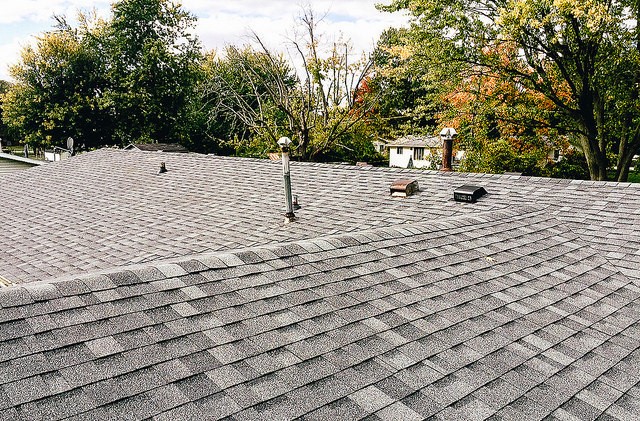Roofs may seem like simple, uniform elements, but roofing shingles come in various styles and materials, each with unique benefits and characteristics. In this article, we will take a closer look at the various types of roofing shingles available today.
Different Types of Roof Shingles
The following are the most common types of roof shingles.
-
Asphalt shingle
Asphalt shingles are a top choice among homeowners. Some of the reasons are because they are affordable. They are also quite versatile since they come in various styles and types.
There’s the architectural type, textured like wood shakes, and three-tab asphalt shingles with uniformity. Just define your choices; you will almost certainly find what you desire.
In addition to all of the above, asphalt shingles are also attractive. They are crafted from organic or fiberglass material coated with asphalt and protective granules.
With all of that being said, another noteworthy thing about asphalt shingles is their lifespan and durability. The durability of an asphalt shingle depends on the specific type.
For instance, the architectural type offers the longest lifespan. It can last up to 50 years. On the other hand, the three-tab shingles and the basic type last around 20 years.
You should, however, note that climate impacts their longevity. Asphalt shingles in warmer locales will likely need quicker replacements than those in cooler locales.
Fortunately, you can extend an asphalt roof’s lifespan between 15–30 years with regular maintenance. These include gutter cleaning, debris removal, and repairs.
-
Metal shingles
Metal Shingles provide homeowners with various options for their roofing needs. These lightweight and easy-to-install shingles offer an ideal solution for roofs that can’t bear heavy materials.
As long as the metal shingles you intend to use mirror the design of the asphalt, slate, or wood shingles, you will find them lightweight. These types of metal shingles bring regular aesthetic appeal and extra durability.
Another good thing about these shingles is that they can maintain their long lifespan even with minimal maintenance. They’re available in sizes from 2 feet by 1 foot to 5 feet by 1 foot.
Some of the material choices you can choose from include:
- Aluminum: Lasts up to 45 years. It is energy-efficient and recyclable.
- Copper: Rust-resistant, minimal maintenance, and has a lifespan of over 100 years.
- Steel: Available in varieties. Depending on the variety you get, rust and corrosion resistance varies.
- Tin: Lasts up to 70 years with regular maintenance.
- Zinc: It can withstand weather conditions thanks to its protective coat. Lasts 100 years.
- Lead: Lasts a century with proper maintenance.
-
Wood shingles
Wood Shingles offer an environmentally friendly roofing option that exudes timeless charm. Depending on the wood type you choose, these shingles are quite durable and offer high energy efficiency levels.
However, despite their appeal, wood shingles come with some considerations. They are susceptible to quick-fire outbreaks compared to other materials and demand proactive measures against mold and termites.
You must regularly maintain them by either power washing them for mold prevention or fumigating them to kill wood pests. These actions are crucial to preserving their condition.
There are two distinct types of wood shingles available. They are wood shakes and wood shingles. Shakes are crafted from white cedar, and they have a textured appearance.
Meanwhile, shingles are sourced from various tree species like cypress and redwood. They often have a uniform look.
Both styles require ongoing maintenance to combat rot and other issues. With proper care, wood shingles can last up to 20–30 years.
-
Tile shingles
Tile shingles offer a stylish, enduring roofing solution that suits various architectural styles. They are traditionally crafted from clay, terracotta, and slate, but the modern variations include metal and concrete.
This roofing choice flourishes in Mediterranean and Spanish-style designs, yet its versatility spans homes of diverse aesthetics.
Tile’s longevity varies, with some lasting over a century while others endure for 20–30 years. Minimal maintenance helps to prolong its lifespan, but periodic inspections and debris removal are key to enhancing its longevity.
Different tile materials present distinct benefits:
- Concrete: Affordable, fire-resistant, but heavy and mold-prone.
- Clay: Pricey but durable. They are also available in varied shapes.
- Terracotta: Heat-resistant but durable. It is best for warmer regions.
- Composite: Eco-friendly and lightweight since they can be made from plastic, rubber, or fiber cement.
- Metal: Energy-efficient, low-maintenance, but installation can be complex.
- Slate: Premium choice. It can last up to 200 years but might require structural reinforcement.
While they come with a high cost, their long-term companionship and cooling properties, if properly maintained, can make them a worthy investment.
-
Concrete shingles
Concrete shingles are created from cement, sand, and water. They tend to emulate the look of wood, slate, or clay at a budget-friendly cost and come in diverse colors and styles.
Concrete shingles boast three profiles: flat, medium, and high, each with its unique appearance.
In warmer climates, the heat-resistant nature of concrete and clay shingles becomes valuable. Thanks to their non-combustible and solar-reflective, they enhance energy efficiency.
Though they are pricier and weightier than asphalt shingles, these tiles offer sturdy framing due to their heft.
Conclusion
It is very crucial that whatever shingle you decide to get is the perfect match for you. Proper selection and installation can ensure longevity, enhance curb appeal, and increase the value of a propertyy. If you’re considering a roofing project, let the experts guide you. Choose Roofpro for top-notch roofing installation, maintenance, repair, and replacement services tailored to your needs. Call us at tel:250-248-3400 for a consultation.


